by Robert Victor (Robin)
Hamilton
|
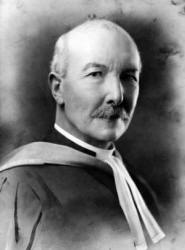
|
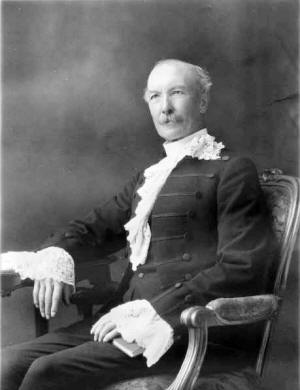
|
|
The late Very Rev. Dr. Robert Wilson
Hamilton
|
The
late Very Rev. Dr. Robert Wilson Hamilton pictured
in his Moderatorial Robes as Moderator of the
General Assembly 1924 to 1925.
|
The late Very Rev. Dr. Robert Wilson Hamilton, third
minister of Railway Street Presbyterian Church, 1885 to 1935,
and Moderator of the General Assembly 1924 to 1925. Dr.
Hamilton wrote a book entitled �A Short Family and Personal
History� which includes a few notes written by his grandson
James Victor Hamilton, who arranged the publication of the
book. His book can be seen on this web site by clicking on:
A short family and personal history 1851 - 1935.
The late Robert Victor (Robin) Hamilton
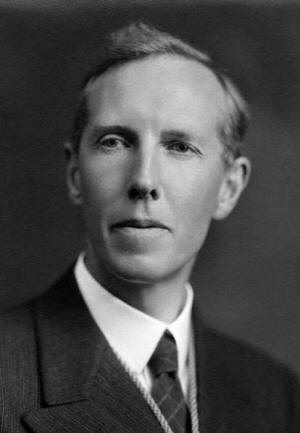 The
late Robert Victor (Robin) Hamilton was the second son of the
Very Rev. Dr. Robert Wilson Hamilton. Robin, a solicitor, lived
at Belvedere, 40 North Circular Road, Lisburn. He was a
lifelong member of Railway Street congregation and for many
years was advisor to the Church Committee. He produced this
typewritten document entitled �A Short History of Railway
Street Church, Lisburn up to 1930� detailing the formation
of the congregation and the planning and building of the
church. However, although it was written with meticulous
accuracy and expertise, the document was never officially
published. The research contained in this document was largely
used to compile several historical articles and it will for many
years to come, continue to be a very important part of the
history of Railway Street Presbyterian Church, Lisburn.
The
late Robert Victor (Robin) Hamilton was the second son of the
Very Rev. Dr. Robert Wilson Hamilton. Robin, a solicitor, lived
at Belvedere, 40 North Circular Road, Lisburn. He was a
lifelong member of Railway Street congregation and for many
years was advisor to the Church Committee. He produced this
typewritten document entitled �A Short History of Railway
Street Church, Lisburn up to 1930� detailing the formation
of the congregation and the planning and building of the
church. However, although it was written with meticulous
accuracy and expertise, the document was never officially
published. The research contained in this document was largely
used to compile several historical articles and it will for many
years to come, continue to be a very important part of the
history of Railway Street Presbyterian Church, Lisburn.
James
Victor Hamilton
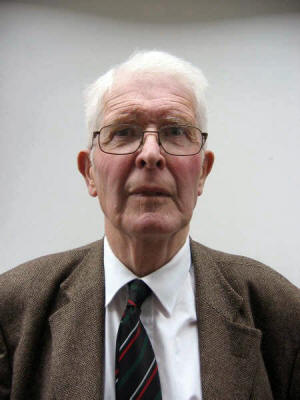 James
Victor Hamilton is the grandson of the Very Rev. Dr. Robert
Wilson Hamilton, and son of Robert Victor (Robin) Hamilton who
lived at Belvedere, 40 North Circular Road, Lisburn. Victor,
like his father Robin, was also a solicitor. Now retired and
living in Holywood, Victor is currently providing invaluable
assistance in researching the history of Railway Street
Presbyterian Church for a book being produced to commemorate the
150th anniversary of the formation of the
congregation on 13th November 1860. Also, as
mentioned above, Victor was responsible for the publication of
his grandfather�s book entitled �A Short Family and Personal
History� and the book includes a few notes added by Victor.
James
Victor Hamilton is the grandson of the Very Rev. Dr. Robert
Wilson Hamilton, and son of Robert Victor (Robin) Hamilton who
lived at Belvedere, 40 North Circular Road, Lisburn. Victor,
like his father Robin, was also a solicitor. Now retired and
living in Holywood, Victor is currently providing invaluable
assistance in researching the history of Railway Street
Presbyterian Church for a book being produced to commemorate the
150th anniversary of the formation of the
congregation on 13th November 1860. Also, as
mentioned above, Victor was responsible for the publication of
his grandfather�s book entitled �A Short Family and Personal
History� and the book includes a few notes added by Victor.
|
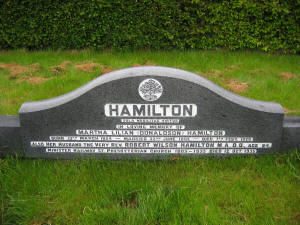
|
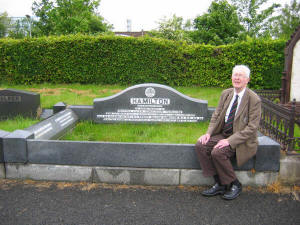
|
|
The Hamilton family grave at Lisburn
cemetery.
|
James Victor Hamilton pictured at the Hamilton
family grave at Lisburn cemetery in 2005.
|
|
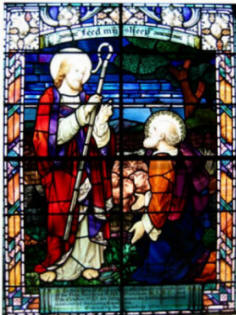
|
Window in memory
of the Very Rev. Dr. Robert Wilson Hamilton
A
stained glass church window erected by the
congregation in remembrance of the Very Reverend Dr.
Robert Wilson Hamilton, M.A., D.D., who died on 12th
October 1935, was unveiled on Sunday 19th
June 1938 by Dr. Hamilton�s older son, Dr. Burt
Hamilton from Manchester.
The window depicts Jesus saying to Peter �Feed my
Sheep.�
The inscription on the window
is:
To the Glory of God and in
affectionate remembrance
of the Very Reverend R. W. Hamilton M.A., D.D.,
died 12th October 1935, for 50 years the
faithful and beloved
minister of this congregation.
Erected by the members,
1938. |
|
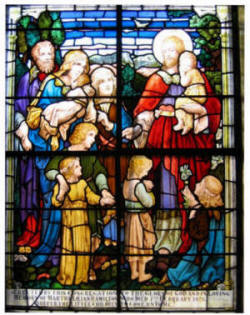
|
Window in memory of
Dr. R. W. Hamilton�s wife Martha Lilian
A
stained glass church window erected by the
congregation in remembrance of the Very Reverend Dr.
Robert Wilson Hamilton�s wife Martha Lilian, who
died on 7th February 1928, was unveiled
on Sunday 1st March 1931 by Dr.
Hamilton�s older son, Dr. Burt Hamilton from
Manchester.
The window depicts
Jesus holding a child and saying,
�Suffer the little
children to come unto me�.
The inscription on
the window is:
Erected by the congregation to the
Glory of
God,
and in loving
memory of
Martha Lilian Hamilton who died 7th
February 1928.
�Suffer The Little Children To Come Unto Me.�
|
First Lisburn, one of the earliest
Presbyterian Congregations in Ireland started in the 17th
Century, found their Church at the time of the 1859 Revival
quite inadequate to hold all its people. So a substantial body
of the members decided to go out and found a second Church. The
first reference in the Minutes of the Dromore Presbytery under
date 7th December 1859 records that a Memorial was
read from a number of Presbyterians residing in Lisburn and its
vicinity asking the Presbytery to erect them into a congregation
and supply them with the preaching of the Gospel.
The
Presbytery appointed a Commission to deal with the matter and
also asked the Belfast Presbytery to co-operate. It has to be
remembered that 1st Lisburn at this time and for many
years after belonged to the Belfast Presbytery.
On 3rd
January 1860 the Commission reports that the Belfast Presbytery
would not co-operate but that �they are of the unanimous opinion
that a Second Presbyterian congregation in that place is
imperatively called for�. At this meeting a Memorial from
upwards of 120 people who promised to pay about �40 per annum
being read the Presbytery resolved: �That the Memorialists be
supplied with the preaching of the Gospel �� at half past 4 each
Sabbath�. Suppliers were to be paid 15/-. The Commission of
the Presbytery included the Rev. Moorhead of Loughaghery,
grandfather of Mrs. T.H. McDonald.
The
difficulty of finding temporary premises in which to hold
Services and a site on which to build a Church proved
considerable. With undue optimism they thought that Dean
Stannus, Rector of the Cathedral and Agent for the Marquis of
Hertford, might assist. A deputation requested him to permit
Services in the Court House. This latter request was refused
and as to a site the fiat was believed to be: �From Dunmurry to
Ballinderry not one foot of ground shall be granted for such a
purpose�. However Mr Jonathan Richardson of Killeaton, to whose
memory all honour, came to the rescue and permitted the new
Congregation to worship in a hall or loft in Castle Street where
they remained for upwards of three years.
At this early
juncture there was one of the very rare controversies that split
the congregation into two parties. One desired to call the Rev.
John Powell, a minister without charge from the South of
Ireland, who conducted services in Lisburn and at times supplied
2nd Lisburn for the Presbytery. The other favoured
Mr. David John Clarke, a licentiate of the Down Presbytery. On
the latter being called in 1861 Mr. Powell applied to the
Secession Synod and founded what is now known as Sloan Street
Congregation. Mr. John Sloan of Plantation House, an elder in
Railway Street and father of James E. Sloan, who later on
presented the site of the Fort Manse, gave some ground in Sloan
Street and the building now used as a Primary School was
erected. Mr. Powell was followed by the Rev. J. W. Gamble and
in 1887 they joined the General Assembly.
David John
Clarke.
On the new Minister there thus fell a heavy burden. He had
to provide a Church and a Manse and he had to seek to weld
together a congregation which had already shown some sign of
disintegrating. Mr. Clarke was a son of the Manse. His father,
the Rev. Thomas Clarke, was the Minister of Magherahamlet, near
Ballynahinch. When he received the call to Lisburn he was only
twenty-six. He had been educated at the Royal Belfast
Academical Institution, the old Queens�s College and the
Assembly�s College. He was clearly a man of very considerable
ability and faced up to his various difficulties bravely.
The first
committee elected in November 1860 consisted of: W.J. Harvey,
Treasurer; John Anderson, Francis Smith, Secretary; David
Graham, Chairman, Andrew Todd, Henry Colvin, James Meneilly,
Hugh Brownlee, William Beggs, William Innis, John McClung,
Jas.Chambers and Robert Edmunston. No session appears to have
been appointed till 1868.
Having failed
to get any of the undeveloped land, of which there was plenty,
from the Dean, our forbears were fortunate when the present site
came on the market. It cost about �350. Building the Church
cost about �2000. Subsequently the Schools at the back about
1869 and the Manse, with small house adjoining, lying to the
north of the Church, were erected. Mr Clarke lived in the small
house and the larger house intended as a Manse was let.
On 29th
March 1863 the foundation stone of the new Church was laid by
John Lyttle, Mayor of Belfast and on 6th March 1864
the Reverend Doctors Henry Cooke and James Morgan came from
Belfast to preach the opening sermons. Dr. Cooke was then of
May Street and his Statue commonly known as �the Black Man�
stands in front of Inst. Dr. Morgan had been in 1st
Lisburn but was now in the old Fisherwick Church on the site of
the Church House, Fisherwick Place.
The
Presbytery meeting for the first time in the new Church on 5th
April 1864 passed a vote of thanks to Mr. Jonathan Richardson
for providing the temporary premises in Castle Street, and
congratulated the members on the �taste and beauty� of their
�most elegant Church�.
During these
early years William Barbour, J.P., the founder of the Hilden
firm of Linen Thread Manufacturers and grandfather of the late
Sir. J. Milne Barbour, Bart., was a tower of strength to the
young congregation. The tablet erected after his death in 1875,
close to the seat he occupied describes him as �one of the first
members and the most munificent contributor to the funds of the
Church�. At one point he offered pound for pound for pound in
connection with a special effort and wrote a cheque for �436 to
meet the liability.
So in 1866
Mr. Clarke was able to report this to the Presbytery and that
the Congregation was almost free from debt. The Presbytery
recorded this in their Minutes and appointed a deputation to
wait on Mr. Barbour and convey to him a resolution acknowledging
his �princely liberality�.
The first
elders, elected in September 1868, were: David Graham, Henry
Colvin, John Ellison, Fredric Duncan and Robert Henry. In 1871
John Sloan, John Neill and Alexander Davison were added.
In 1878 Mr.
Clarke died. He was only forty-five and apparently had been in
poor health for some time. By this time there were about 220
families and about 200 Stipend payers.
When one
considers the comparatively small numbers one has to realise
that Mr. Clarke in building a Church of this size was
courageously looking ahead.
He was keenly
interested in education and was for a while Manager of four
National Schools: The Boys and Girls Schools behind the Church,
The Hilden School and the School at Largymore. This last
finally involved him in a lawsuit in which he was evicted from
the School at the instigation of the Lisburn Estate office of
the Marquis of Hertford. It is clear that he never managed to
be �persona grata� with the potentates.
Largymore
School had been erected by Captain Bolton, R.N., a
public-spirited gentleman, who had obtained a lease from the
Marquis. It was generally known as �Bolton�s School�. The
Captain furnished the School, paid the teachers, and defrayed
all expenses; no doubt it filled a very useful place in that end
of the town. On his death the Estate Office took over its
management and later on it was handed over to the Cathedral.
For several
years Mr. Clarke acted as one of the honorary Secretaries of the
Bible & Colportage Society and in his earlier days had worked
for a time with the Belfast Town Mission. He was a member of
the Relief Committee and took a very active part in the work in
connection with the Cotton Famine (1862-3), due to the American
Civil War, which caused great hardship in Lisburn.
Mrs. Clarke
(formerly Mrs. McKinstry) survived her husband for many years
and will be remembered as a regular attender at the Church
Services.
James Lyle
Bigger
Mr. Clarke�s successor was a man of rather a different
stamp. He was a most distinguished Scholar and had achieved
countless successes in the Schools and Universities he
attended. He was a son of William Finlay Bigger, J.P., a member
of the well-known family in Londonderry who are still leaders in
the Pork Curing trade in Ulster.
In 1870 he
entered the Royal Belfast Academical Institution. From there he
proceeded to the old Queen�s College, Belfast where he obtained
1st Class Honours in the B.A. and M.A. examinations.
From Queen�s he went to Edinburgh University where he was
awarded a B.D. He also attended Magee University College,
Londonderry, where he was afterwards a Professor. The Bigger
Memorial Prize in Hebrew is called after him and is still
annually awarded at Magee.
Mr. Bigger
was licensed to preach on 6th May and on 16th
October 1879 was ordained as successor to Mr. Clarke. Although
lacking in parochial experience Mr. Bigger, during his short
stay, proved a worthy successor to Mr. Clarke. In those days
Bible Classes were not as common as they became later and Mr.
Bigger was a born teacher. The result was that even members of
the Church of Ireland and Methodists were in the habit of
attending his classes.
Another
matter that exercised him was the raising of money to clear off
the building debt. During his stay something like �1400 was
raised towards meeting the old debt and for Church extension.
It was during his ministry that the wall round the Church
property was erected.
It was hardly
likely that a man of his scholarly tastes would spend his life
in Parish work and so there was little surprise when in 1885 he
accepted the Chair of Oriental Literature and Hermeneutics at
Magee. Here he remained till his early death in 1890.
He was a
member of the Royal Asiatic Society and it is to him that the
early interest of the congregation in Foreign Missions may be
attributed. Among his published works, were �The Revised
Pentateuch� and �The Battle Address of Abijah.�
Mr. Bigger
resided at �Elmwood� on the Belsize Road and his first advice to
his successor was never to live in the Manse in Railway Street.
In fact it was always well let and none of the Ministers ever
lived in it. Mrs. Bigger, who like her husband, was extremely
popular was a daughter of Professor Watts of Belfast and like
Mrs. Clarke survived her husband for many years.
Robert
Wilson Hamilton
While the first two Ministers had but short reigns, the next
one remained in Lisburn for 50 years from his arrival in 1885.
He was the son of Henry Stewart Hamilton of Trentagh House, St.
Johnston, County Donegal, and at the time of his Call to Railway
Street was placed in Burt, a few miles from Londonderry.
Obviously he was well known to Mr. Bigger. So although the
�Call�, which is still extant, is signed by all and sundry,
there is little doubt that Mr. Bigger chose his successor.
In so far as
Mr. Hamilton was known at all to members of the Congregation it
was due to his taking part in a series of Evalangelistic
Services in Belfast the previous winter and to having preached
once in Railway Street. At an early age he had gone to America
and there coming under the influence of the well known Rev. Dr.
John Hall, had thrown up a promising business career and entered
Princeton University. Here he obtained an M.A. degree. Later
on, in 1924, when he became Moderator of the General Assembly,
Princeton awarded him an honorary D.D.
His health,
in America, not being too good, he came back to the old country
and took his Theological Course at Magee and Edinburgh
University.
In 1880 he
was called to Burt, County Donegal, where he was of course among
his �ain folk�. His interest in the land, in horses and in
flowers remained with him even after a lifetime in Lisburn.
Although the
name of the Congregation was not officially changed from �2nd
Lisburn� to �Railway Street� till the year 1894 the Menu at the
Ordination on 8th October 1885 is headed �Railway
Street Presbyterian Church�.
Hand
written addition here:
The Rev. W. Moorhead of Loughaghery,
son of the member of the original Commission mentioned above,
once remarked that his chief recollection of the services in
Castle Street was the new congregation did not want to be called
�2nd Lisburn�.
By 1885 the
Church was showing every sign of prosperity and it is unlikely
that any new arrival will be offered such an array of viands.
After toying with Oxtail or Oyster Soup, one had a choice of 5
joints followed by Roast Turkey or Roast Chicken. Six sweets
came next and the speeches which followed seemed to be on the
same generous scale.
There were
about 272 families and the new Minister found himself in a very
different atmosphere from Donegal. He was a scholar like Mr.
Bigger. But he was young, enthusiastic and evangelistic. On
the whole, the part of his work he liked best was the going out
and in among the people he came to love so much.
He was
appointed, almost at once, Chaplain to the Workhouse, now the
Lagan Valley Hospital, but then, especially in winter, crammed
with �Casuals�. There was a Service for the inmates every
Sunday afternoon and in those days many a hard body ended his or
her days in �The Big House�.
Two things
seem to have impressed one coming from the country. First, it is
not easy to bring up a family on 12/= a week if you live in a
town. 14/= or 15/= per week was an exceptionally good wage.
Second, the drunkenness in Lisburn on a Saturday night had to be
seen to be believed. Liquor was cheap � Stout at 1� d and
Whiskey at 2/6 or less a bottle. �Look at me for 4d� was
something more than a joke. Nor was it much fun to the Mill
owner to find that after a pleasant Sunday as bona fide
travellers his key workers were not in their best form on Monday
morning.
The ladies of
the Congregation formed a Dorcas Society, visited the poorer
members, especially those with young children and at Christmas
parcels and money were distributed.
In 1890 the
Temperance Institute was built to a great extent with money
provided by members of the Society of Friends and the Owners of
the principal Mills.
The
congregation came to take an increased interest in Foreign
Missions and when the first World Wide Missionary Conference was
held in Exeter Hall in 1888 Mr. Hamilton represented the Irish
Presbyterian Church.
As the years
went on there was a good deal of building. The Lecture Hall,
with its furnishings, cost about �500 in 1887. The Upper Room
was formerly approached by a stairway from outside. This was
reconstructed and Side Galleries put into the Church at a cost
of about �1400. Mrs. Robert Barbour of New Jersey, a daughter
in law of William Barbour, who always worshipped here when in
Ireland, lent the Fort House and a most successful Bazaar was
held in 1896.
At an early
date the Committee desired to build a new Manse and had gone the
length of getting the Presbytery�s consent to sell the original
Manse and small house near by in 1886. They picked what is now
Fort Hill as a suitable site. Sir Richard Wallace, however,
objected as he feared building there would interfere with the
view from the Castle (now the Technical School) and its gardens
which ran down to the Railway.
By 1899 Sir
Richard and Lady Wallace were dead and the estate had, for the
most part, been sold. Mr. James Edgar Sloan, U.D.C. of
Plantation House, a son of the John Sloan mentioned above, now
the purchaser of the Fort Hill and a staunch member of the
Congregation, offered the present site as a free gift. So the
Fort Manse was built in 1900 at a cost of about �1100.
Under the
will of Miss. Isabella Brownlee whose family had been connected
with the Congregation pretty well from the start, the Church
benefited considerably.
In particular
it made possible, with the assistance of the National Board of Education the erection and equipment in 1913 of the Brownlee
Memorial Schools and Teachers Residence at a cost of about
�7000.
These were
subsequently transferred to the Regional Education Committee,
but the congregation is still represented on the Management
Committee.
1910 was
Jubilee Year. The congregation had been formed for 50 years.
And Mr. Hamilton had been Minister for twenty-five. So there
was a great Congregation Meeting on 16th November.
Mr. James Carson, whose �Letters of a Banker� in the �Lisburn
Standard� are still remembered, gave a short history of the
congregation and presentations were made to Mr. and Mrs.
Hamilton.
John McClung
was the one survivor present of the foundation office bearers 50
years before.
The Members
of Session in 1910 were: William J. Fraser, J.P. (Clerk of
Session), David Kilpatrick, Hugh G. Larmor, J.P., (Treasurer)
David McCluggage, John McClung, John McKittrick and J. Laurence
Rentoul, M.B., J.P. The Secretary was George Duncan and the
Assistant Treasures Hugh Maybin, B.A.
On the death
of Mrs. Elise Milne Barbour it was found that she had left �250
to the Congregation. Her husband (afterwards the Rt. Hon. Sir
Milne Barbour Bart P.C., M.P.) enquired how it was proposed to
use this. As there had been, back to the days of William
Barbour, an afternoon Sunday School, run by the Church, in the
Mill Dining Room, it was felt that this might be used as the
nucleus of a Hall in Hilden where the Sunday Schools and other
meetings could be held. In the end Sir Milne built the E.M.B.
Hall and generously added to the endowment.
Naturally
some changes took place over the years. Fermented wine ceased
to be used at Communion in 1889; Hymns and ultimately in 1908 an
organ were introduced. The present instrument and the clock in
the gallery being a gift from the late James Crossin, J.P.
There were,
of course, a few breezes as it would hardly be expected that all
the older members would welcome such innovations. But there was
never a real storm.
Numerous
Series of Evangelistic Services took place and there will be
some who remembered:- John Anderson of Paisley, the Rev. Andrew
Boyd, the Rev. Gordon Clements, John Quincey Adams Henry,
William Nicholson and La Marechale.
By 1898/9 it
was found desirable to have an Assistant. The first one was the
Rev. Steele H. Rentoul, a son of the Rev. James Rentoul of
Dromore. His successors are dotted all over the province and
some like himself and the Very. Rev. A.W. Neill, who died in his
Moderatorial year, have passed on.
In 1924 Mr.
Hamilton was made Moderator and in 1928 Mrs. Hamilton, who had
taken an immense interest in the work of the congregation and
for many years conducted a Bible Class for Young women died.
In 1930 Dr.
Hamilton (as he had then become) retired and on 12th
October 1935 he died.
HAND
WRITTEN ADDITION IN THE DOCUMENT
Apart from work in connection with
the General Assembly in which he remained interested to the
last, he was on numerous public boards. He was Governor of the
Co. Antrim Infirmary (now the Lisburn Hospital), of the
Intermediate School (now the Wallace High School), and of
Princess Gardens School in Belfast. He was a member of the
Committees of the Assembly�s College in Belfast, of the
Temperance Institute and of the Thompson Memorial Home.
APPENDIX
A. MEMORIALS
There are tablets in the Vestibule giving the names of those who
served in the 1914 �18 war and those who fell in the 1939 to
1945 war and there is a stained glass window in the Church to
the Memory of the fallen in the first of these wars.